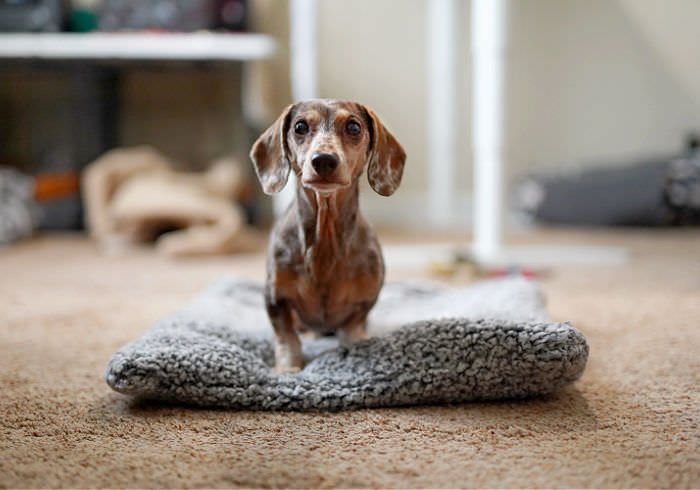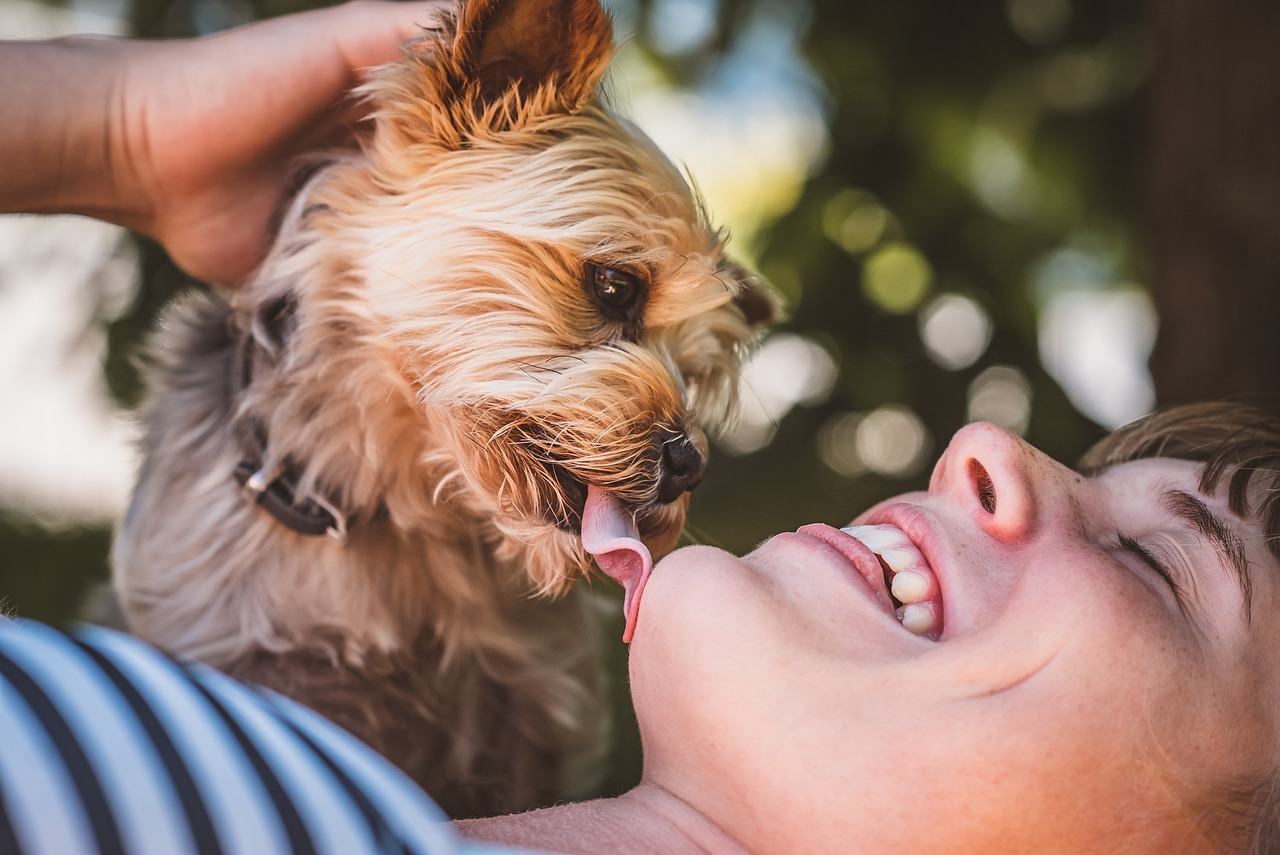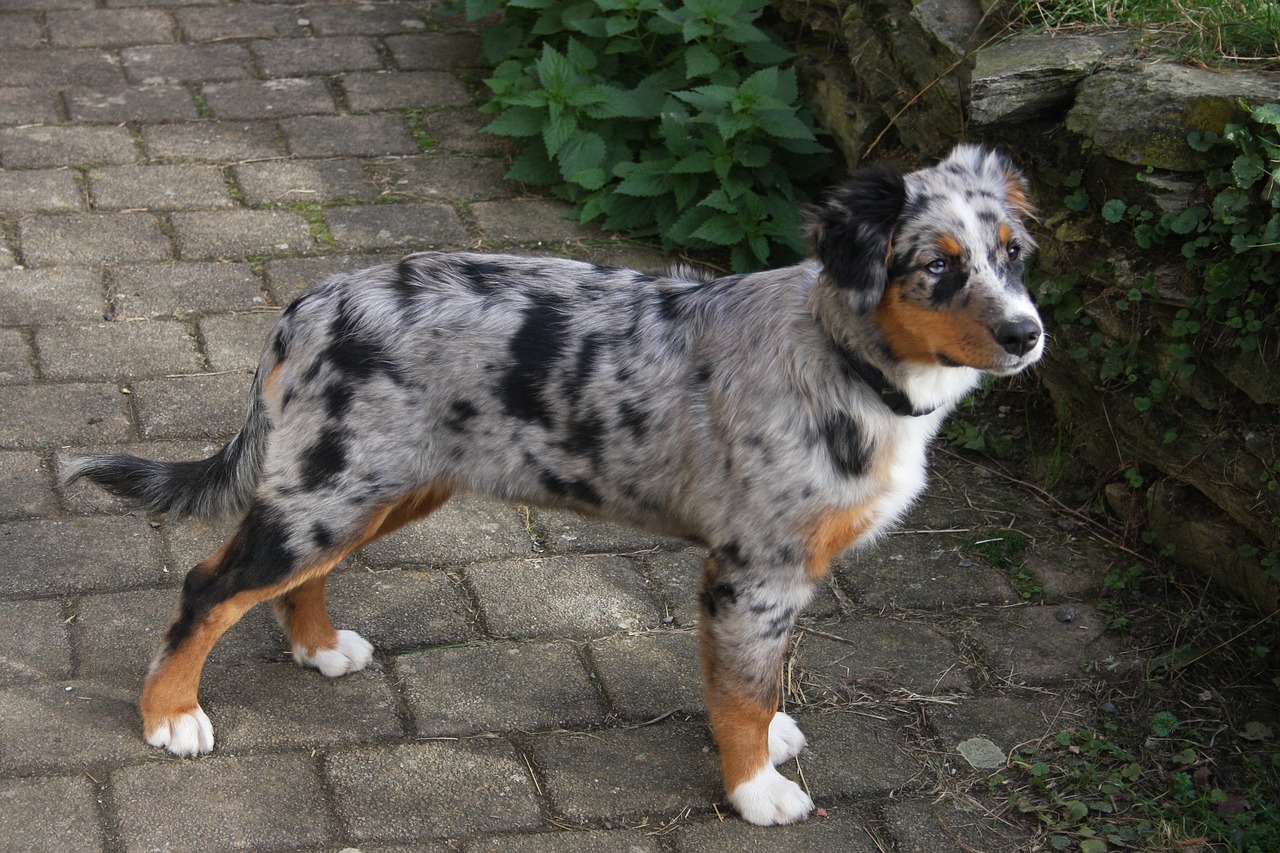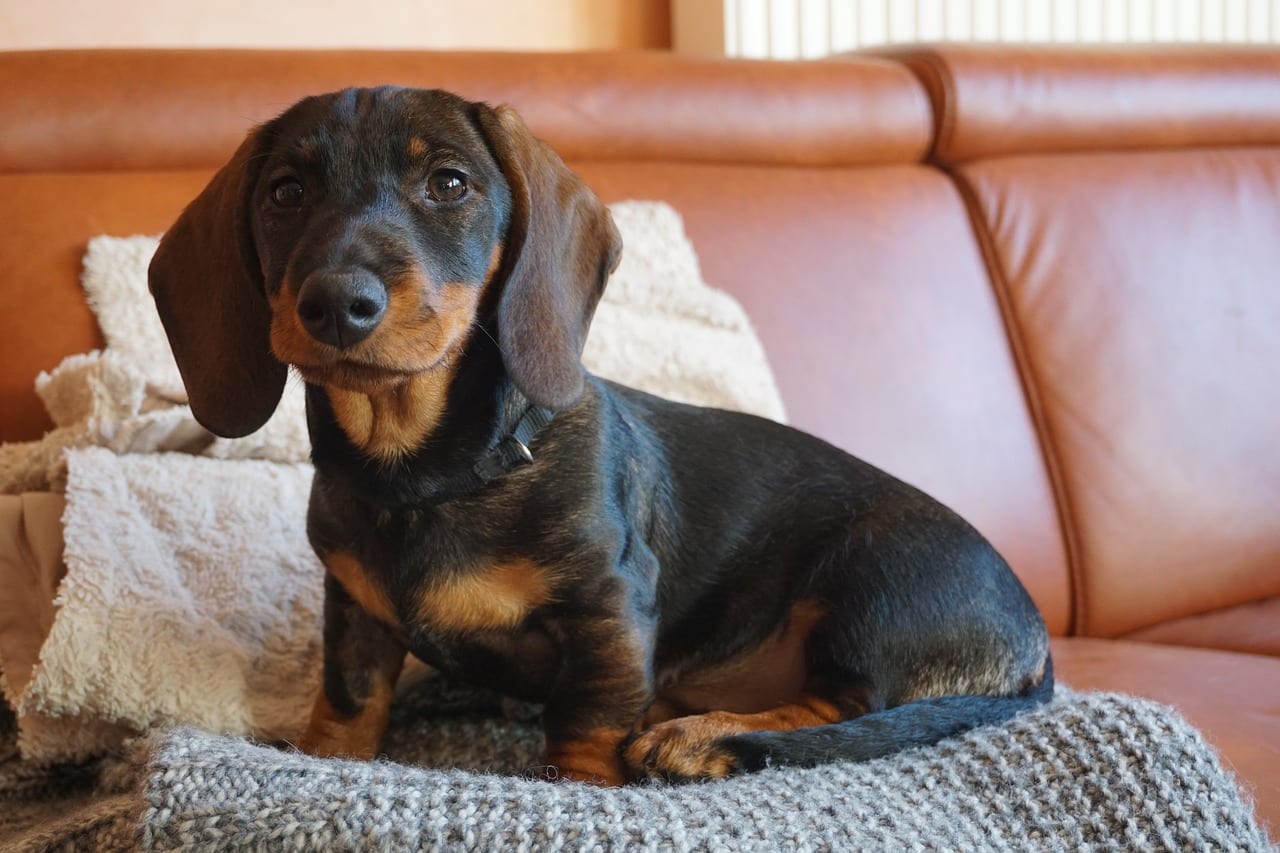Dachshunds are a breed that is especially prone to nervousness and fear.
If yours often shakes, looks nervous, or barks excessively and destroys things when you’re gone, you are probably looking for a way to stop Dachshund anxiety.
My Dachshund Gretel was so anxious when I adopted her that the rescue had put her on prozac.
I have managed to greatly increase her feeling of confidence and security since her gotcha day in late 2012, but it is still her default behavior and something I need to continue to manage on a regular basis.
Below are the things I have tried or that I know have worked for other Dachshund owners.
The best starting place for calming your Dachshund’s anxiety is to figure out what is causing it in the first place.

What Causes Anxiety in Dachshunds?
Anxiety in dogs refers to a state of fear or apprehension caused by certain situations or stimuli.
It is a normal emotion that all dogs experience at some point, but when it becomes excessive or chronic, it can be considered an anxiety disorder.
Dachshund anxiety can be caused by a variety of factors, including:
- Separation anxiety
- Phobias (noise is one of the most common)
- Fear
- Socialization issues
- Trauma
- Genetics
- Certain medical conditions
There are several ways to help your dachshund overcome anxiety.
However, if your Dachshund has suddenly become anxious, the first thing you should do is visit your veterinarian to rule out any underlying medical conditions.
9 Signs of Anxiety in Dachshunds
Dachshunds can show a variety of signs of anxiety, and it’s important to recognize them so you can help your dog feel more comfortable and calm.
Here are some common signs:
1) Restlessness
Dachshunds with anxiety may have trouble settling down, pacing or circling around the room, or continually shifting positions.
When my first Dachshund Chester developed dementia, I could tell me was anxious in unfamiliar places because he would pace and not settle.
2) Panting or excessive drooling
Dogs with anxiety may pant heavily or drool excessively, even when they are not hot or thirsty.
Panting made sense to me because I have seen it in dogs that experience anxiety while riding in the car.
But I recently dog sat a Dachshund who would drool so much around a group of dogs that it was like someone turned a faucet on.
I had never seen a Dachshund drool that much before!
3) Excessive barking or whining
Dogs with anxiety may bark or whine excessively.
If this happens while you, or your Dachshund’s chosen person, is not around it’s a classic sign separation anxiety.
4) Destructive behavior
Destructive behavior is one of the primary signs of separation anxiety in Dachshunds.
If your Dachshund barks excessively, pees or poops, scratches at the walls or carpet, or chews furniture or other objects when you leave the house, or even a room, it’s very likely due to separation anxiety.
5) Shaking or trembling
While Dachshunds are known to shake or tremble if it’s even slightly chilly, it can also be a cause of anxiety.
Trembling and shaking is so typical in Dachshunds that it may be difficult to determine whether it’s caused by anxiety or something else, but it’s likely anxiety if accompanied by any other signs on this list.
6) Reactivity and aggression
Some Dachshunds may become aggressive when they are anxious, especially if they feel threatened or cornered, and react to the threat in a defensive manner.
This most typically manifests at barking and lunging at other dogs, skateboards, or people while on a leash.
The second primary way this manifests is as resource guarding of toys, food, or people if they feel like what they are hyper-attached to will be taken away.
7) Avoidance or hiding
Dachshunds with anxiety may try to avoid certain situations by hiding under furniture or in a closet or running away from what is giving them anxiety.
8) Changes in appetite
Some Dachshunds may lose their appetite or have trouble sleeping when they are anxious.
I often watch Dachshunds in my home and I know when one is anxious because their parents left because they refuse to eat for the first day.
Pain can also induce stress, which is why a food-motivated Dachshund suffering from a back injury will probably not take a treat from you.
Do remember that a Dachshund may also refuse to eat if they are too distracted or over-stimulated in a good way, so this is not always a sign of bad stress.
9) Changes in sleep patterns
This one is kind of related to restlessness above but is a bit different.
While restlessness typically appears as agitation or impatience, changes in sleep patterns are more obvious and disruptive.
For example, if your Dachshund normally sleeps through the night but it suddenly getting up several times a night, it could be due to anxiety.
Medical conditions can also cause this, but the cause likely won’t be apparent if it’s anxiety (unlike throwing up or having to go potty).
If you have observed your Dachshund’s behavior – both body language and behavior in certain situations – and have determined that your pup has anxiety, you’ll want to address that.
How to Stop Dachshund Anxiety
Disclosure: Some of the links in this article are affiliate links (Amazon Associate or other programs we participate in). As an affiliate, I earn a small commission from qualifying purchases.
While some of these potential solutions will stop your Dachshund’s anxiety, if it is severe, it may only reduce it to a more tolerable level.
Also keep in mind that not all of these work for all anxious Dachshunds, and they won’t always work forever.
In my experience, you’ll likely have to try many different techniques, and probably end up having to use several different methods in conjunction with each other.
And sometimes, what was working stops being effective, so you have to add in another technique or try a different one altogether.
But here 10 methods known to potentially reduce or eliminate anxiety in dogs:
1) Music or white noise
Playing calming music, white noise, or leaving the radio on can help drown out loud or sudden noises that can trigger anxiety in your Dachshund.
If your dog is accustomed to hearing regular noise, the occasional bark, knock, or bang may be less noticeable to them.
2) Provide a safe and comfortable environment
Dachshunds thrive in environments that are safe, secure, and comfortable.
Providing a cozy bed, toys, and a crate can help make your Dachshund feel safe and secure.
It’s also important to create a routine for your Dachshund to help them feel more comfortable and secure that they know what to expect.
However, don’t be too strict with a routine or that can cause different behavior issues.
There is something to be said for teaching your Dachshund to be flexible too.
Here is one example of what I mean:
My Dachshunds know that they eat twice a day – once in the morning and once in the evening. This is predictable and they know they will always be fed.
I don’t always feed them using the same bowl though and it’s not always at the exact same time every day.
While dinner time is usually at 430 pm, sometimes I do it at 4 pm and sometimes as late as 530.
If they start to pester me for dinner but I don’t get up and make it, they settle back down and wait patiently.
3) Training and socialization
Training and socialization are crucial for helping your Dachshund overcome anxiety.
Training can help your Dachshund understand what is expected of them (remember to be consistent with your expectations!)
Socialization can help them become more comfortable around different people and dogs, less scared by loud noises, and comfortable in different environments.
4) Exercise and playtime
Dachshunds are active dogs and need regular exercise to stay happy and healthy.
If a Dachshund doesn’t get enough exercise, one of the signs may be anxiety.
Exercise can also help reduce anxiety and stress in your Dachshund if it’s present.
Taking your Dachshund for regular walks, playing fetch, or engaging in other physical activities can help burn off excess energy and reduce anxiety.
If you’re unable to go for a walk, try playing interactive games indoors such as tug-of-war or hide-and-seek to help them get the exercise they need.
5) Desensitization training
Desensitization training involves gradually exposing your Dachshund to the things that trigger their anxiety, such as loud noises or unfamiliar people, in a controlled and positive environment.
For example, if your dog is afraid of loud noises like thunder or fireworks, you can gradually expose them to these sounds by playing a recording of the noise at a low volume and gradually increasing the volume over time.
Start with a volume level that does not cause your dog to become anxious or fearful and gradually increase the volume as your dog becomes more comfortable.
Or if your Dachshund has separation anxiety, you can gradually desensitize them to being alone by starting with short periods of time away from your dog and gradually increasing the duration.
You can also make your departures and arrivals low-key and calm and provide your dog with a special treat or toy to keep them occupied while you’re away.
Rewarding your Dachshund for calm behavior with treats, toys, or praise can help boost their confidence and reduce anxiety.
Remember never to scold or punish your Dachshund for being scared of something or force them to interact with it when they are clearly uncomfortable, because that can worsen anxiety.
Over time, your Dachshund may become desensitized to their anxiety triggers.
6) Anxiety wrap
Anxiety wraps are snug-fitting shirts that wrap around your Dachshund’s body and provide a calming effect by applying gentle pressure similar to a hug.
They can be especially helpful during thunderstorms or fireworks.
The most common dog anxiety wrap, and the one you are most likely familiar with, is the Thundershirt.
7) Aromatherapy and pheromone therapy
Aromatherapy
Certain scents can have a calming effect on dogs, such as lavender or chamomile.
Be sure to dilute the oils properly and avoid using them around your Dachshund’s face.
To be on the safe side, you can purchase an essential oil, or essential oil spray, made specifically for dogs.
Pheromones
Mother dogs communicate with their puppies through natural “messages” released in the air called pheromones.
These pheromones provide a strong signal of security and comfort to dogs because the smell reminds them of their mother.
Synthetic pheromones, like Adaptil, are available in sprays, diffusers, or collars and can help reduce anxiety in dogs.
8) Treat toy to keep them occupied
If you have a food motivated Dachshund, giving them a stuffed treat toy , natural chew, or lick mat to distract them from what is stressing them can help reduce anxiety.
If I am leaving the house, giving my dogs a stuffed treat toy in their crate helps distract them when I walk out the door and keeps them focused on something else besides me being gone for a while.
By the time they are done with it, they are often tired enough to go to sleep.
Also, if we are in situation where my Dachshunds might see something that will upset them, I may give them a chew or lick mat to give them a new focus.
If you choose to do this outside of the house though, just beware that food may attract another dog who follows the scent into your dog space, thus making the situation worse not better.
Use your best judgement, stay aware of your surroundings, and be willing to advocate for your dog if needed.
9) Massage
Massaging your Dachshund can help reduce stress and anxiety by promoting relaxation and increasing circulation.
Use gentle, circular motions and start with areas your Dachshund enjoys being touched, such as the shoulders, back, or ears.
10) Calming supplements
There are several calming supplements available for dogs that can help reduce anxiety.
I’ve tried many of them and many natural calming supplements didn’t work on Gretel’s high level of anxiety.
However, a few did:
You can read more: How CBD can help your Dachshund’s anxiety.
Supplements containing chamomile, valerian root, or L-theanine have also helped some dogs.
Two important notes though:
- It’s important to consult with your veterinarian before giving your Dachshund any supplements
- To be effective for anxiety, all of these may need to be given in double or triple doses.
What’s Worked Best for My Dachshunds
As I said, my Dachshund Gretel was so anxious when I adopted her, she was on Prozac for it.
Because I had so much time to devote to her, and had experience rehabilitating fearful and anxious animals, I didn’t keep her on the mediation and instead, tried all of the techniques above.
While Gretel still has separation anxiety, and situational anxiety based in fear, I’m able to manage it and she lives a mostly calm, happy life.
I also use some of these methods for my Dachshund Summit in order to help prevent anxiety in the first place and address any minor issues that may come up.
What did work for us:
- Music/white noise
- Safe, comfortable environment
- Socialization
- Desensitization training
- Exercise
- CBD
- Giving her a stuffed treat toys or lick mats
I don’t use all of these methods to reduce her anxiety all of the time.
It depends on the situation and the severity of her anxiety in that particular situation.
Things that didn’t help my Dachshund’s anxiety:
- Anxiety wrap
- Aromatherapy
- Pheromones
- Massage (she loves them but getting one doesn’t help her anxiety)
- Herbal calming supplements
I think these things didn’t work for us because Gretel’s anxiety is so severe.
I’ve heard other Dachshund owners have some success with them though so don’t discount these options just because they didn’t work for us.
Final Thoughts
Dachshund anxiety is a common issue, but it can be managed with the right techniques.
Providing a comfortable environment, regular exercise, training and desensitization, and using calming aids can help your Dachshund overcome anxiety and live a happier, healthier life.
Remember, if your Dachshund’s anxiety persists despite your best efforts, it may be time to seek professional help.
A veterinarian or animal behaviorist can help determine the underlying cause of your Dachshund’s anxiety and develop a treatment plan.
They may recommend medication, behavior modification techniques, or a combination of both.



